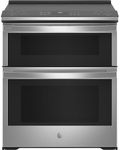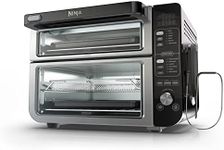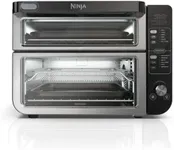Buying Guide for the Best Double Ovens
Choosing the right double oven can significantly enhance your cooking experience, providing you with the flexibility to cook multiple dishes at different temperatures simultaneously. When selecting a double oven, it's important to consider various specifications to ensure it meets your cooking needs and fits well within your kitchen space. Here are some key specs to consider and how to navigate them.CapacityCapacity refers to the amount of space available inside the oven for cooking. This is important because it determines how much food you can cook at once. Double ovens typically have two separate compartments, and their combined capacity can vary. Smaller capacities (around 4-5 cubic feet) are suitable for smaller households or those who don't cook large meals often. Medium capacities (5-7 cubic feet) are ideal for average-sized families, while larger capacities (7+ cubic feet) are perfect for those who frequently entertain or cook large meals. Consider your cooking habits and the size of your household when choosing the right capacity.
Fuel TypeDouble ovens can be powered by either electricity or gas. Electric ovens are known for their even heating and precise temperature control, making them great for baking. Gas ovens, on the other hand, heat up quickly and are often preferred for roasting and broiling. Your choice between electric and gas should depend on your cooking preferences and the existing setup in your kitchen. If you already have a gas line, a gas oven might be more convenient. If you prefer consistent baking results, an electric oven could be the better option.
ConvectionConvection ovens use a fan to circulate hot air around the food, resulting in faster and more even cooking. This feature is important for those who want to reduce cooking times and achieve consistent results. Some double ovens have convection in one or both compartments. If you frequently bake or roast, a convection oven can be a valuable addition. For occasional use, a standard oven without convection might suffice. Consider how often you cook and the types of dishes you prepare to decide if convection is necessary.
Self-CleaningSelf-cleaning ovens use high temperatures to burn off food residue, making cleaning easier. This feature is important for maintaining your oven without the hassle of manual scrubbing. There are different types of self-cleaning options, such as pyrolytic (high heat) and steam cleaning. Pyrolytic cleaning is more thorough but requires higher temperatures, while steam cleaning is gentler and quicker. If you cook frequently and want to minimize cleaning effort, a self-cleaning oven is a good choice. For occasional use, manual cleaning might be manageable.
Control TypeControl types for double ovens can range from simple mechanical knobs to advanced digital touchscreens. This spec is important because it affects ease of use and precision in setting temperatures and cooking times. Mechanical controls are straightforward and reliable, while digital controls offer more features like preset cooking programs and timers. If you prefer simplicity and reliability, mechanical controls are a good option. If you enjoy using advanced features and want more precise control, digital controls might be better suited for you.
Size and InstallationThe size and installation of a double oven are crucial to ensure it fits well in your kitchen space. Double ovens come in various widths, typically ranging from 24 to 30 inches. It's important to measure the available space in your kitchen and choose an oven that fits comfortably. Additionally, consider the installation type—whether it's built-in or freestanding. Built-in ovens offer a seamless look and save space, while freestanding ovens are easier to install and move. Choose based on your kitchen layout and installation preferences.













